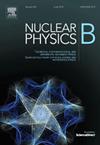Magnetic suppression of cosmic rays' flux in f(R) and f(Q) theories of gravity
IF 2.5
3区 物理与天体物理
Q2 PHYSICS, PARTICLES & FIELDS
引用次数: 0
Abstract
We investigate the effects of magnetic diffusion on the spectrum of ultra-high energy cosmic rays (UHECRs) from a cosmological perspective. To this end, we consider two modified theories of gravity (MTGs), namely, the gravity and a symmetric teleparallel gravity, also known as gravity. Utilizing these two MTGs, we calculate the suppression in the flux of UHECRs for a collection of sources. Non-evolution (NE) and cosmic star formation rate (SFR) scenarios have been considered in our calculation of the suppression factor. This study also includes a mixed composition scenario involving the nuclei upto iron (Fe). Furthermore, we provide a parameterization of the suppression factor for the proton and also for the mixed compositions within the and theories, considering both NE and SFR scenarios. The influence of the turbulent magnetic field on the suppression factor is also incorporated in our work. Comparative analysis of all our results with the standard ΛCDM model reveals significant effects of MTGs on the suppression factor that the power-law model predicts the lowest suppression factor, while the model predicts the highest, and interestingly the results from the standard model fall within the range predicted by these two cosmological models.
求助全文
约1分钟内获得全文
求助全文
来源期刊

Nuclear Physics B
物理-物理:粒子与场物理
CiteScore
5.50
自引率
7.10%
发文量
302
审稿时长
1 months
期刊介绍:
Nuclear Physics B focuses on the domain of high energy physics, quantum field theory, statistical systems, and mathematical physics, and includes four main sections: high energy physics - phenomenology, high energy physics - theory, high energy physics - experiment, and quantum field theory, statistical systems, and mathematical physics. The emphasis is on original research papers (Frontiers Articles or Full Length Articles), but Review Articles are also welcome.
 求助内容:
求助内容: 应助结果提醒方式:
应助结果提醒方式:


